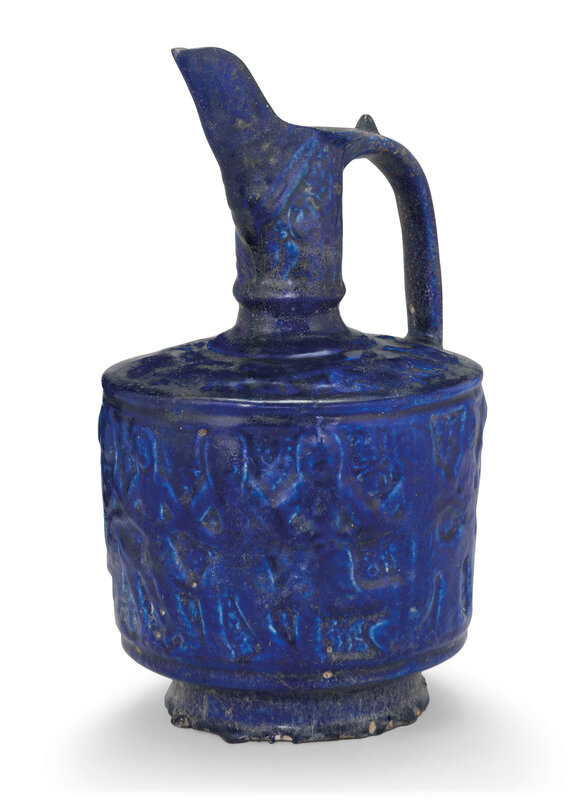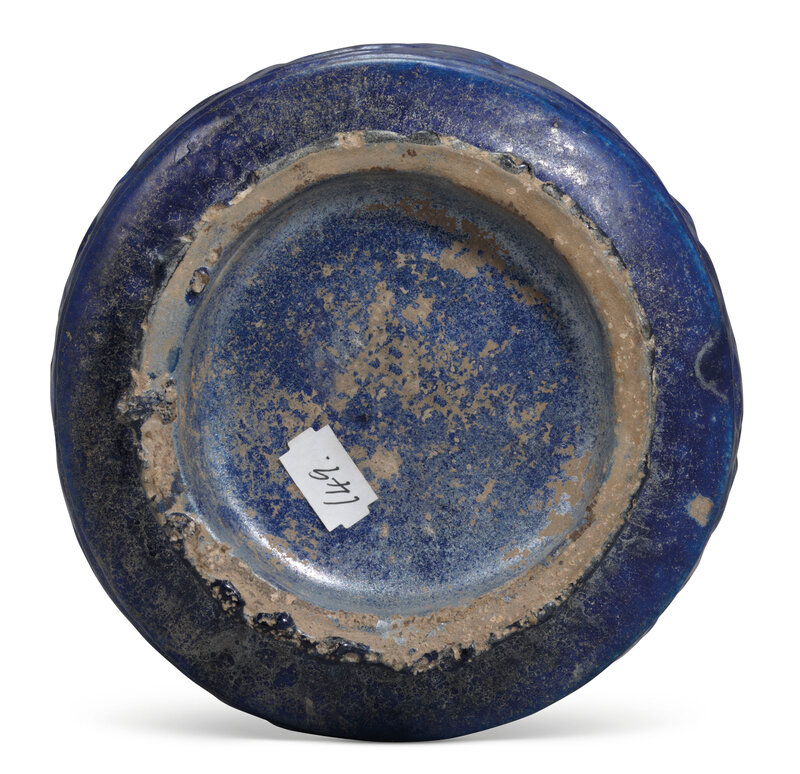A large moulded cobalt-blue ewer, Kashan, Central Iran, circa 1200
Lot 3. A large moulded cobalt-blue ewer, Kashan, Central Iran, circa 1200; 12 ¼in. (31cm.) high. Estimate GBP 20,000 - GBP 30,000 (USD 25,600 - USD 38,400). © Christie's Images Ltd 2020.
The cylindrical body decorated with scrolling vine around a band of dancing figures with linked arms, the flat shoulder with traces of animals in chase, the neck and mouth with floral motifs, some areas of restoration.
The Collection of the Late Dr. Mohammed Said Farsi.
Note: The body of this ewer is moulded with a lively design of dancers linking arms. It is one of a group known to have been produced in moulded fritware covered with a cobalt or turquoise glaze. Whether the motif represents a particular dance or whether it is an expression of the joie de vivre of life at court is unclear, but different explanations have been put forward for its possible significance. Ettinghausen and Bausani propose that it is a representation of the dastaband, the 'dance of the Magi', the fire-worshippers of the Zoroastrian religion (Ettinghausen, 1965, pp.211-24 and Bausani, 1968, p.548). It has also been suggested that the form of the dance, with the holding of hands and the position of the legs, finds parallels in an ancient Turkic tradition which appears to survive from the pre-Islamic period until the 15th century (Grube, 1994, pp. 159-60, no. 151). Ettinghausen remarks that portrayal of similar scenes on luxury goods, including silver-inlaid bronzes, lustre and polychrome painted pottery indicates their decided appeal to the wealthy and even the palace (Ettinghausen, 1965, p.224).
Turquoise and cobalt glazed ewers with the same design are in the David Collection, the Ashmolean Museum and the Detroit Institute of Arts (Folsach (ed.), 1996, p.253, no.231, Fehérvàri, 1973, p.76, pl.E, no.64 and acc.no. 31.55). Another, from the collection of Raymond Ades is published in Bahrami, 1949, pl. VII. Two, one turquoise glazed, the other cobalt glazed are in the Khalili Collection (Grube, 1994, pp. 159-60 and p.170 , nos.151 and 160). A cobalt glazed jar with similar decoration, formerly in the Parish-Watson Collection, sold at Sotheby's, 14 April 2010, lot 142. A ewer of very similar form, design and colour sold in these Rooms, 7 April 2011, lot 43.
Christie's. Art of the Islamic and Indian Worlds Including Oriental Rugs and Carpets, London, 2 April 2020

/https%3A%2F%2Fprofilepics.canalblog.com%2Fprofilepics%2F1%2F0%2F100183.jpg)
/https%3A%2F%2Fstorage.canalblog.com%2F03%2F02%2F119589%2F96711876_o.jpg)
/https%3A%2F%2Fstorage.canalblog.com%2F11%2F31%2F119589%2F94773502_o.jpg)
/https%3A%2F%2Fstorage.canalblog.com%2F20%2F83%2F119589%2F94772815_o.jpg)
/https%3A%2F%2Fstorage.canalblog.com%2F26%2F72%2F119589%2F75604929_o.jpg)
/https%3A%2F%2Fstorage.canalblog.com%2F59%2F60%2F119589%2F26458628_o.jpg)





/http%3A%2F%2Fstorage.canalblog.com%2F10%2F53%2F119589%2F126222564_o.jpg)
/image%2F1371349%2F20240311%2Fob_875cd2_dac1749b-73d0-4aff-b50f-43b42efe9eb3.jpg)
/http%3A%2F%2Fstorage.canalblog.com%2F33%2F88%2F119589%2F128942361_o.jpg)
/http%3A%2F%2Fstorage.canalblog.com%2F94%2F98%2F119589%2F128936844_o.jpg)